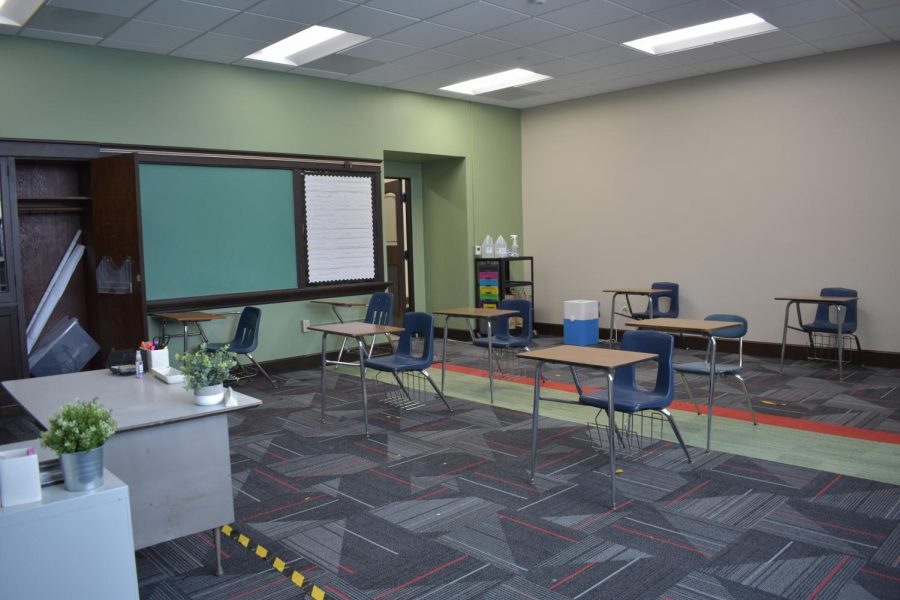Students voice opinions on hybrid switch
A newly-renovated classroom arranged with distanced desks and hand sanitizer at the door to fit COVID guidelines. Hybrid students will return to school on February 22.
Shorewood students and families were tasked with a difficult decision: choosing whether their kids should return to Hybrid education two days a week, or remain in the Virtual+ model for the rest of the third quarter. For most, in-person opportunities are more rewarding academically and socially, but the risks associated with attending school pose significant challenges.
“I think the most important thing is just making sure that it is safe for you to go back, personally, because everyone is obviously in a different place with COVID,” said Sadie Cumberbatch, senior and student representative on the school board.
Cumberbatch, along with approximately 60% of the student body, has chosen the hybrid model because she is confident that risks will be minimized as much as possible through school protocols, and she misses opportunities to communicate with her peers.
“It’s my senior year, so I want to go back. I want to experience my last semester as normally as possible, and when I can go back I will go back,” Cumberbatch said.
Cumberbatch does not live with anyone at high risk of severe illness from the virus, nor is she herself, which helps simplify her decision. For other students this may not be the reality.
“I definitely did not want to be going out in public and then going to school and seeing all these people, and then exposing myself to my grandparents especially since they are both over 80,” said Niamh Hade, junior. “We are in a pandemic and I just don’t think it is worth the risk.”
Hade lives above her grandparents in a duplex, and her family takes many precautions to make sure they are minimizing the chance of transmission.
“Our entire family has basically been trying to avoid them, and whenever we do come in contact with them we try to keep our distance and we are always wearing masks. We only see them about twice a week,” Hade said.
Hade also doesn’t want to make a transition to a whole new model of learning, and is less inclined to come back for social reasons as many of her friends would be on campus for the other hybrid days.
“I just didn’t want to have to try to adjust to a whole new thing,” Hade said. “And having already adjusted to this new virtual thing for the whole school [year], I just figured it would be a lot easier. A lot of my friends are in the other group, so we would never see each other even in the hallways or anything and I thought that might make it a lot more difficult to even hang out with them outside of school.”
For other students the lack of socialization during the school day is more than enough reason to return to school, even if they may not be on campus the same day as their friends.
“I decided to go hybrid because I need the socialization with it, because I’ve been very isolated and I also think that I will have a better understanding of the material I am supposed to be learning,” said Jamie Puppe, junior.
Even though it may be difficult to make the transition, Puppe is hopeful that once she adjusts she will reap the benefits of having increased academic engagement and peer support.
“I think everyone acknowledges the risk that is associated with going back to school. I know for me at least, because I haven’t seen that many other people, it’s going to be a big adjustment to be surrounded by so many people again” Puppe said.
Regardless of the decision Cumberbatch, Hade or Puppe made, they all emphasized the importance of making safe individual decisions and minimizing exposure through mask-wearing and other precautions.
“From what I understand, the transmission from schools isn’t that high, so I think as long as people are enforcing masks and distancing then it should be ok,” Puppe said.
“I feel like it’s mostly just a personal choice, but people need to know that their actions affect everyone else. If you choose to not wear a mask and you choose not to be really careful then you’re hurting other people as well,” Hade said.
“Make sure you are making the right decisions; be informed,” Cumberbatch said.

